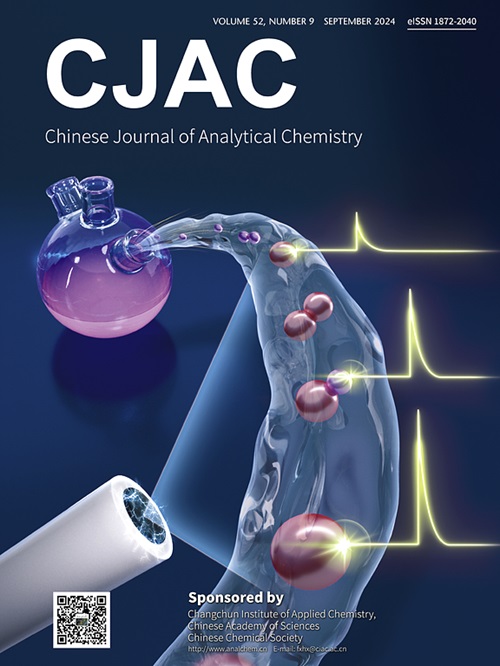Alterations in plasma metabolome and correlation with urinary metabolome in cardiac surgery-associated acute kidney injury using ultra high-performance liquid chromatography-high resolution mass spectrometry
IF 1.3
4区 化学
Q4 CHEMISTRY, ANALYTICAL
引用次数: 0
Abstract
Cardiac surgery-associated acute kidney injury (CSA-AKI) may be related to an increase in mortality in patients in the intensive care unit; therefore, developing potential candidate molecule is particularly important for disease prediction and early diagnosis. This exploratory study investigated the alteration of the plasma metabolome profiles and possible links with the urinary metabolome in six patients with CSA-AKI at different time points, which could screen out the differential plasma metabolites for statistical analysis and altered metabolic pathways. After performing receiver operating characteristic analysis to obtain potential candidate molecules, the differential plasma metabolites with Level 1 were used for correlation analysis with the urinary metabolome. The plasma metabolome of the AKI group could be clearly separated from that of the uninjured kidney or recovered groups, but the plasma samples from recovered and uninjured groups could not be distinguished using statistical analysis. Compared with the uninjured kidney group, significant changes in the plasma metabolome were observed in such patients with CSA-AKI, especially regarding amino acid metabolism, spermidine and spermine biosynthesis, and sulfate/sulfite metabolism. The potential candidate molecules in the plasma metabolome, such as carnitines, exhibited a significantly positive correlation, while carnitines and organic acids in the plasma were involved in the correlation with the urinary metabolome. Plasma metabolic disorders were observed when CSA-AKI occurred, and the systemic status of recovered patients returned to normal after treatment. This exploratory investigation suggests potential candidate molecules in plasma and possible links to the urinary metabolome in CSA-AKI.

超高效液相色谱-高分辨率质谱分析心脏手术相关急性肾损伤患者血浆代谢组的变化及其与尿代谢组的相关性
心脏手术相关急性肾损伤(CSA-AKI)可能与重症监护病房患者死亡率增加有关;因此,开发潜在的候选分子对疾病的预测和早期诊断尤为重要。本探索性研究探讨了6例CSA-AKI患者在不同时间点血浆代谢组谱的改变及其与尿代谢组的可能联系,从而筛选出差异血浆代谢物进行统计分析和改变的代谢途径。在进行受体工作特征分析以获得潜在的候选分子后,使用水平为1的差异血浆代谢物与尿代谢组进行相关性分析。AKI组血浆代谢组与未损伤组或恢复组血浆代谢组可以明显分离,但恢复组和未损伤组血浆样品无法通过统计分析进行区分。与未损伤肾脏组相比,CSA-AKI患者血浆代谢组发生了显著变化,特别是在氨基酸代谢、亚精胺和精胺生物合成以及硫酸盐/亚硫酸盐代谢方面。血浆代谢组中的潜在候选分子,如肉毒碱,表现出显著的正相关,而血浆中的肉毒碱和有机酸与尿代谢组相关。CSA-AKI发生时观察血浆代谢紊乱,治疗后患者全身状态恢复正常。这项探索性研究提示了CSA-AKI患者血浆中潜在的候选分子及其与尿代谢组的可能联系。
本文章由计算机程序翻译,如有差异,请以英文原文为准。
求助全文
约1分钟内获得全文
求助全文
来源期刊
CiteScore
3.60
自引率
25.00%
发文量
17223
审稿时长
35 days
期刊介绍:
Chinese Journal of Analytical Chemistry(CJAC) is an academic journal of analytical chemistry established in 1972 and sponsored by the Chinese Chemical Society and Changchun Institute of Applied Chemistry, Chinese Academy of Sciences. Its objectives are to report the original scientific research achievements and review the recent development of analytical chemistry in all areas. The journal sets up 5 columns including Research Papers, Research Notes, Experimental Technique and Instrument, Review and Progress and Summary Accounts. The journal published monthly in Chinese language. A detailed abstract, keywords and the titles of figures and tables are provided in English, except column of Summary Accounts. Prof. Wang Erkang, an outstanding analytical chemist, academician of Chinese Academy of Sciences & Third World Academy of Sciences, holds the post of the Editor-in-chief.

 求助内容:
求助内容: 应助结果提醒方式:
应助结果提醒方式:


